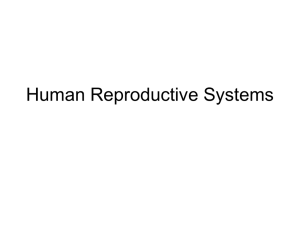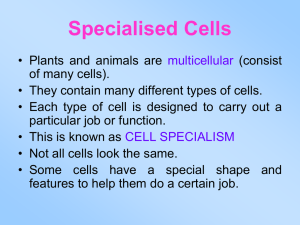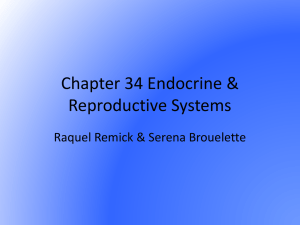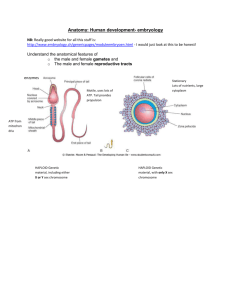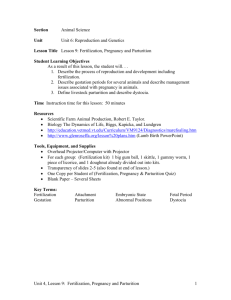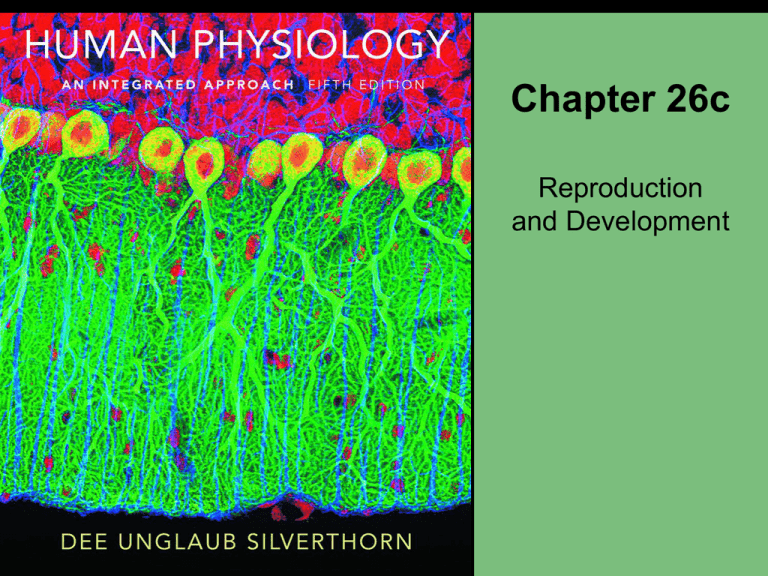
Chapter 26c
Reproduction
and Development
Pregnancy Prevention
• Contraceptives (birth control methods)
• Abstinence
• Total abstinence
• Abstinence during periods of female fertility
• Interventional methods
•
•
•
•
Barriers
Surgery
Blocking implantation
Hormone treatments to reduce gamete production
Pregnancy Prevention
Table 26-5
Fertilization
• Sperm capacitation occurs in vagina
• Sperm swim “upstream”
• Sperm reach oocyte in Fallopian tube
• Acrosomal reaction digestive enzymes
• Zona pellucida and cell junctions dissolve
• Membranes fuse and sperm nucleu enters
• Cortical reaction blocks polyspermy
• Nuclear fusion creates a diploid cell
• 1 sperm + 1 oocyte 1 zygote
Fertilization
Figure 26-16a
Acrosome Reaction Allows Sperm to Reach Egg
Figure 26-16b
Sperm and Egg Fuse to Form a Zygote
First polar
body
Egg
Sperm
nucleus
Sperm and
egg plasma
membranes fuse.
Sperm nucleus
moves into
cytoplasm of egg.
Figure 26-17 (1 of 4, 2 of 4)
Oocyte Completes Meiosis and Nuclei Fuse
Sperm
nucleus
Egg
Oocyte nucleus
completes meiotic
division.
Second
polar body
Sperm and egg
nuclei fuse to
form zygote nucleus.
Figure 26-17 (3 of 4, 4 of 4)
Early Development
• Rapid cell divisions follow fertilzation
• Blastocyst
• Hollow ball of ~ 100 cells
• Arrives in uterus on day 4 or 5
• Implantation
• Blastocyst invades the endometrium
Early Development: Ovulation to Implantation
3 Days 2-4: Cell
division takes place.
2 Day 1:
Fertilization
Zygote
4 Day 4-5: Blastocyst
reaches uterus.
Fallopian
tube
Egg
1 Ovulation
Inner cell mass
Blastocyst
Ovary
Uterus
5
Days 5-9:
Blastocyst implants.
Figure 26-18
Early Development: Ovulation
Fallopian
tube
Egg
1 Ovulation
Ovary
Uterus
Figure 26-18, step 1
Early Development: Fertilization
2 Day 1:
Fertilization
Zygote
Fallopian
tube
Egg
1 Ovulation
Ovary
Uterus
Figure 26-18, steps 1–2
Early Development: Rapid Cell Divisions
3 Days 2-4: Cell
division takes place.
2 Day 1:
Fertilization
Zygote
Fallopian
tube
Egg
1 Ovulation
Ovary
Uterus
Figure 26-18, steps 1–3
Early Development: Blastocyst Reaches Uterus
3 Days 2-4: Cell
division takes place.
2 Day 1:
Fertilization
Zygote
Inner cell mass
Fallopian
tube
Egg
1 Ovulation
4 Day 4-5: Blastocyst
reaches uterus.
Blastocyst
Ovary
Uterus
Figure 26-18, steps 1–4
Early Development: Implantation of Blastocyst
3 Days 2-4: Cell
division takes place.
2 Day 1:
Fertilization
Zygote
4 Day 4-5: Blastocyst
reaches uterus.
Fallopian
tube
Egg
1 Ovulation
Inner cell mass
Blastocyst
Ovary
Uterus
5
Days 5-9:
Blastocyst implants.
Figure 26-18, steps 1–5
Placenta and Continuing Development
• The chorion is a tissue layer that encloses
the developing embryo
• The amnion is a tissue layer that secretes
amniotic fluid, suspending the embryo
• Chorionic villi form a close connection with
blood vessels of the endometrium
• The placenta continues to grow during
pregnancy
The Placenta
Figure 26-19a
The Placenta: Microscopic Anatomy
Figure 26-19b
The Placenta Makes Numerous Hormones
• Human chorionic gonadotropin (hCG)
• “Rescue” of corpus luteum
• Basis of pregnancy tests
• Human placental lactogen (hPL)
• Breast development, metabolic effects
• Estrogen and progesterone
• Critical for maintaining pregnancy, and for
normal development
• Several additional hormones are produced
Parturition: Birth Process
• Prior to labor: softening of the cervix
• Labor
• Rhythmic uterine contractions
• Positive feedback cycle of oxytocin release
• Cervical dilation
• Delivery of the baby
• Placental release and expulsion
Parturition: Birth Process
Figure 26-20a
Parturition: Birth Process
Figure 26-20b
Parturition: Birth Process
Figure 26-20c
Parturition: Birth Process
Figure 26-20d
Regulators of Parturition
• Labor onset
• Possible role of CRH
• Stretch of cervix as a stimulus
• Role of oxytocin in labor
• Stretch stimulates release
• Oxytocin stimulates prostaglandin release
• Positive feedback (contractions stimulate more
oxytocin release)
Parturition Is Controlled by a Positive Feedback
Loop
Figure 26-21
Hormones and Mammary Gland Development
• Puberty
• Estrogen stimulates grow of ducts and fat
deposition
• Pregnancy
• Estrogen, growth hormone, and cortisol
stimulate further gland development
• Late pregnancy
• Progesterone stimulates conversion of some
ducts to secretory epithelium
Mammary Gland Anatomy
Figure 26-22a
Mammary Glands - Microscopic View
Figure 26-22b
Lactation: Control of Milk Secretion
• Before birth
• Prolactin-inhibiting hormone (PIH) blocks
prolactin secretion
• High sex steroid levels suppress milk
production
• After birth
• High prolactin & low estrogen lactation
• Breast milk = nutrients + immunity
• Suckling
• Inhibits PIH, allowing milk production
• Oxytocin stimulates “let-down reflex”
Hormonal Control of Milk Secretion and Release
Higher
brain
centers
Sound of
child’s cry
Hypothalamus
PIH cell
Oxytocin neuron
Portal system
PIH
Anterior
pituitary
Posterior
pituitary
Prolactin
Oxytocin
Milk
secretion
Milk
ejected
Baby
suckling
Ascending sensory information
Inhibition of
prolactin cells
is removed
Smooth muscle
contraction
Mechanoreceptors
in nipple
Figure 26-23
Reproductive Maturation: Puberty
• Maturation of reproductive organs, increased
hormone levels, and onset of gamete
production
• Notable characteristics of puberty
• Females: menarche, pubic hair, and breasts
• Males: pubic hair, beard, and deep voice
• Hormone changes at puberty
• Increased secretion of GnRH
• Increased LH/FSH levels stimulate gonads
• Possible role of leptin
Aging and Menopause
• Causes
• Ovaries cease responding to LH/FSH
• Low levels of estrogen and progesterone
• Cessation of egg development
• Symptoms and therapies
• Hot flashes and increased osteoporosis risk
• Hormone replacement debate
Aging and “Andropause”
• Controversial (only affects 50% of men over
50 years)
• Lower levels of testosterone impact some
men’s lives
• Many men remain reproductively active, despite
low testosterone levels
Summary
• Sex and genetics
• Hormonal regulation of reproduction
• Tissues and hormones involved in
spermatogenesis and oogenesis
• Procreation and contraception
• Fertilization and zygote development
• Labor and delivery
• Puberty, menopause, and andropause






